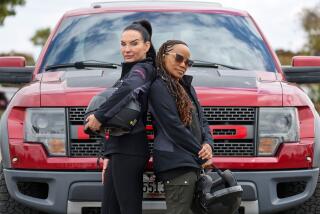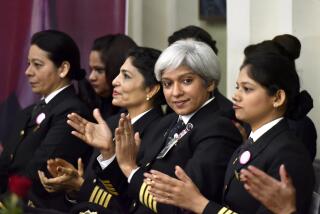Women Increasingly Taking to the Road on Two Wheels
If you think a woman’s place in motorcycling is on the pillion, it’s time for a statistical reality check.
J.D. Power & Associates, famous for crunching numbers for the automobile industry, recently examined the world of two-wheeled motoring with the nation’s first major survey of motorcycle owners, their demographics and buying habits. The study included the role of women in the hobby, and concluded that the “Wild One” image is just about as valid and dated for bikers as “Father Knows Best” is for families.
“There were a lot of surprises that came out of this study,” said Gil Niv, an analyst at Power who oversaw the study of more than 9,000 buyers of 1998 motorcycles. “But one of the biggest was how many women are coming into motorcycling. Of all persons in the survey who were buying their very first motorcycle, 22% were women.
“That is significant [for the industry], especially for the future.”
But for the present, it will not have much effect on the overwhelmingly male-dominated world of motorcycling. Of all buyers of 1998 motorcycles, only about 8% were women, the Power study found. Still, if female percentages remain strong among first-time buyers, Niv noted, women will significantly chip away at that male supremacy.
There were other indications that more women are venturing into the motorcycle world, and not just as passengers.
* About half the women who bought 1998 motorcycles said they had taken the riding course for beginners from the highly regarded Motorcycle Safety Foundation. Only 20% of male buyers had attended the program, which Niv interprets as yet another sign that women are building their numbers within the motorcycle population.
* Women who bought new bikes had about the same household annual income--around $58,000--as men in the survey. At a median age of 38, the women were three years younger than their male counterparts.
* Another significant difference emerged in data involving education levels. About 40% of the woman had college degrees compared to 31% of the men.
“The industry should be paying attention to these women, there is no doubt about that,” Niv said.
But leaf through most general interest motorcycling magazines in this country, and you’ll see maybe only one or two pictures of women riders, usually in group shots taken at rallies. Articles by women or about women riders and their clubs are rare.
The two major British motorcycle magazines, in contrast, regularly profile women riders, and use women as bike reviewers.
Although U.S. motorcycle ads seldom feature women--except as passengers, or as scantily dressed models draped over bikes--at least one major manufacturer is planning to veer from that course.
“Up until now, our ads have not been directed toward women and we have not advertised in women’s publications,” said Bob Moffit, who heads Kawasaki’s marketing efforts in the U.S. “It was just benign neglect, because it has been such a male-dominated industry.”
Even before the Power study was released this month, Moffit was convinced that his industry is changing. Checking his company’s 1996 sales figures, he found that 11% of purchases of 500cc sportbikes were by women. Twelve months later the percentage had grown to 18%, and is expected to jump to 28% by the end of this year.
“You can’t ignore that,” Moffit said. “In 1999 we’ll be targeting women with some of our advertising, and we may be doing some events for women.”
But the ultimate acknowledgment by the industry that bikes are not just for guys will be when manufacturers start building motorcycles scaled down for women.
Manufacturers of skis and golf clubs make shorter versions of their products primarily for the women’s market. But in motorcycles, only laid-back cruiser models tend to be low enough for women riders. Feistier sportbikes and standard--sometimes called naked--motorcycles with their more upright seating positions, typically stand too tall for shorter women.
“It is really frustrating,” said Claire Vitucci, 26, who started riding last year. Because she is only 5 feet tall--the average woman in the Power survey was 5 feet, 5 inches--Vitucci’s choices are extremely limited. Looking at the array of new models shown at the International Motorcycle Show in Long Beach earlier this year, she was faced with one basic consideration before getting around to selecting style or color: “Can I fit on it?”
“Except for cruisers, there was almost nothing there for me,” said Vitucci, who is a reporter for the Associated Press.
She added that other women riders find themselves in the same boat, including a friend who wants to ride a hot new sportbike so badly that she is willing to risk the danger of stopping the bike and balancing machine and herself on tiptoes.
“I think it’s really unfair, and it’s bad business,” Vitucci said of the industry’s tendency to overlook shorter women. “And I told them that.”
If the numbers keep rising, they are bound to listen.







